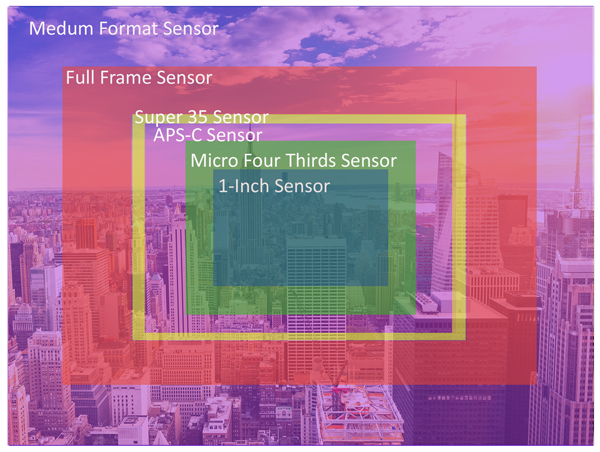We’ll do our best to make this as easy as possible. There are plenty of websites that will explain the technical specs of these two elements but we will keep it simply and apply it to everyday usage.
Types of Sensors and Sizes:
- Medium Format
- 35mm full-frame
- Super 35
- APS-C
- 4/3″ Four Thirds (micro 4/3 or MFT)
- 1″ (one-inch)
- Smaller sensors are noted by their size variations such as 1/2.3″ and 1/1.7″.
There are variations to exact sizes, but the above are the common sizes you will come across.
Sensors and Image Quality
In photography, sensor size has an impact in overall image size and quality. The easiest way to explain sensors is this — the larger the sensor typically means the larger the pixel size, which means, the higher the image quality.
You can find a 20 megapixel camera in any of the sensor sizes, however, the best image quality will be found on a large sensor with a large pixel count. A 20 megapixel full-frame sensor should output a considerably higher image quality than a 20 megapixel 1-inch sensor since the pixels would be larger on the full-frame sensor.
For example, the Nikon D810 is a full-frame sensor with 36 million pixels, the Sony A7RII is a full-frame with 42 million pixels, and the Canon 5DS is a full-frame with 50 million pixels — each of these will offer extremely high image quality — arguably the top three cameras in this class.
Additionally, larger pixels with a lower pixel count, will allow for better low-light performance. A camera like the Sony A7S and A7SII only have 12 million pixels on a full-frame camera, however, this still allows for a high image quality with exceptional low-light performance.
A full-frame sensor gets its name because it is the same size as a horizontal frame of 35mm film used for photography — the industry standard which the other sizes now use as the primary reference.
A super 35mm sensor is equivalent to a vertical frame of 35mm film used for cinematography. For filmmakers, a APS-C sensor is actually closer in size to a film camera which is why some high-end cameras like the Sony A7RII have a Super 35 4K mode which actually presents a higher video quality than the 4K full-frame mode.

Focal Length and Crop Factor
Focal length is the size of the lens. The greater the focal length, the closer the lens will be to the subject. A focal length of 100mm will be considerably closer to a subject than a focal length of 35mm. In general, focal lengths are based on the 35mm standard which is why you will see cameras and lenses generally providing the 35mm equivalent if not a 35mm (full-frame) lens. Typically, lenses are designed for the sensor format, and yes, some are interchangeable.
In short, if a lens is designed for a full-frame camera, there will be cropping if used on a smaller sensor. If a lens designed for an APS-C sensor is used on a full-frame camera, the image will not fill the frame.
Crop factor is typically based on the diagonal size of a full-frame 35mm sensor.
So if you have a 50 mm lens on a full-frame camera, it would always be a 50mm field of view. However, an APS-C camera would have a 1.5x crop factor, meaning that same 50mm lens would be equivalent to a 76mm field of view. A micro 4/3 camera has a 2x crop factor, meaning that same 50mm lens would have a 100mm field of view.
Also keep in mind that depth of field will also increase with sensor size, and larger sensors will require a smaller aperture to maintain the same depth of field. Is this getting confusing yet? If so, it’s time to enroll in our free “Basics of Photography” class!
Resolution Types and Sizes
While 1080p is still the delivery standard, the momentum is quickly shifting to UHD (ultra high definition) which comes in at 3840×2160. The size of UHD is double HD, but in actuality it delivers 4x the pixel count so it is really 4x better quality. 4K cinema (4096×2160) and 2K offer an aspect ratio more consistent with traditional cinema. This is one of the reasons why the Panasonic GH4 has been so popular since it has a setting to provide cinema 4K.


